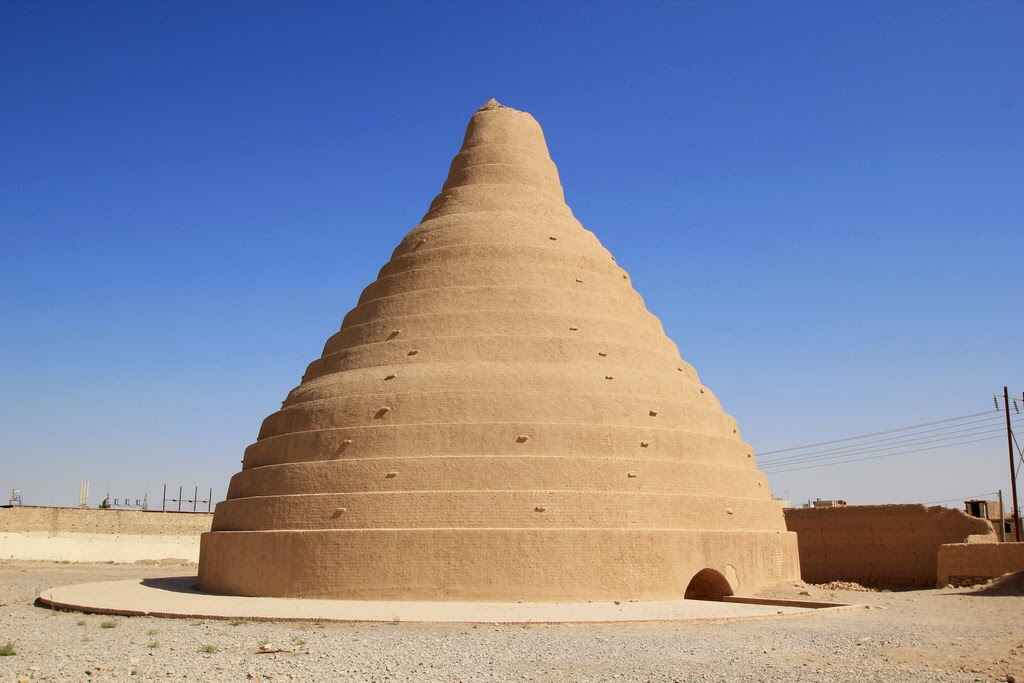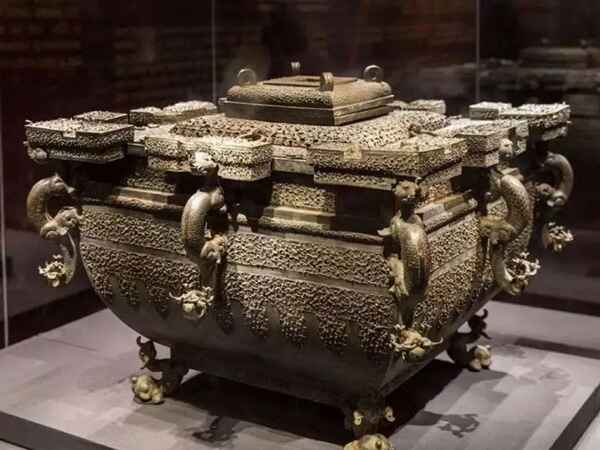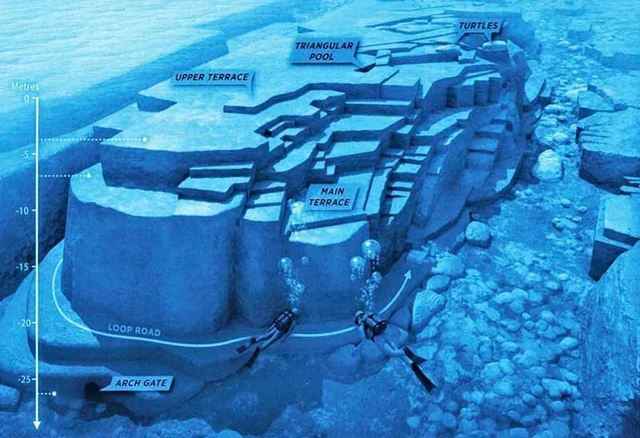Imagine a time when ice was a luxury, reserved only for the wealthiest. Yet, in the heart of the scorching Persian desert, ancient engineers crafted an ingenious structure—the Yakhchal—that could store ice year-round without modern technology. This ancient Persian marvel not only defied the harsh climate but laid the foundation for refrigeration as we know it today. In this article, we’ll uncover five mind-blowing facts about the Yakhchal, revealing how this ancient innovation continues to influence modern cooling systems. Keep reading to discover the secrets of a 2,000-year-old invention that still astounds scientists and architects alike.
The Ingenious Invention of the Yakhchal
In the heart of ancient Persia, long before the advent of modern refrigeration, the people of this desert civilization invented something extraordinary: the Yakhchal. This architectural marvel, whose name literally means “ice pit” in Persian, was not merely a structure; it was a testament to human ingenuity and the profound understanding of natural principles.
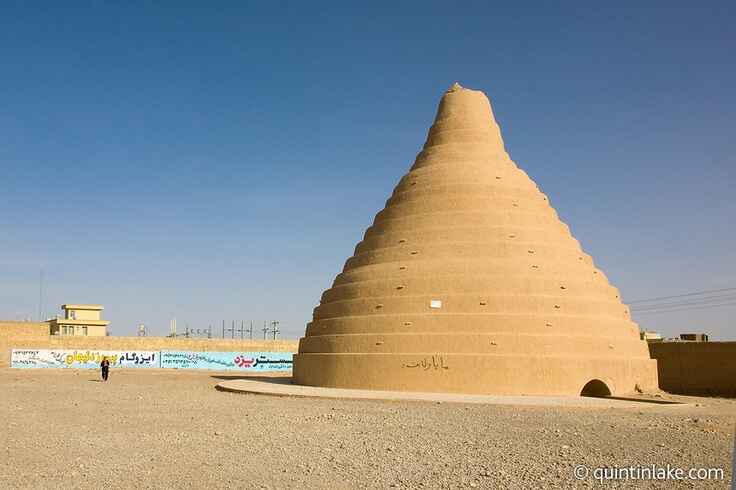
The Yakhchal, first appearing in historical records around 400 BCE, served a crucial purpose in a region where the scorching summer sun could easily reach unbearable temperatures. The ancient Persians, aware of the challenges posed by their harsh environment, needed a way to store ice throughout the year. The Yakhchal was their solution, a seemingly simple yet brilliantly effective structure that allowed them to preserve not only ice but also food and other perishables.
Constructed using a combination of clay, sand, and specific natural insulators, the Yakhchal was designed to harness the principles of evaporation and thermal inertia. Its towering dome, often reaching heights of up to 60 feet, was key to its functionality. The thick walls, made from a special mortar called sarooj, were critical in maintaining low temperatures inside, regardless of the external climate. Beneath this dome lay a deep pit, where ice would be stored, kept cool by the natural insulation provided by the earth itself.
The Yakhchal’s effectiveness was further enhanced by its location, strategically built near qanats—underground water channels—that provided a steady flow of cool water. These structures were meticulously designed to channel wind into the dome, promoting cooling through evaporation. What seemed like a simple mud-brick structure was, in reality, a sophisticated, passive refrigeration system, capable of keeping ice solid even during the hottest months of the year.
The Origins of Yakhchals: A Glimpse into Ancient Persia
The origins of the Yakhchal trace back to the ingenious minds of ancient Persian engineers, who, in their quest to conquer the relentless desert heat, developed a system that was nothing short of revolutionary. Around 400 BCE, in a time when most civilizations were still grappling with the basic challenges of food preservation, the Persians had already begun constructing these remarkable ice houses.
The inspiration behind the Yakhchal was rooted in the necessity of survival in an unforgiving climate. Persia, with its arid deserts and sweltering summers, presented a significant challenge for storing perishable goods. The Persians, ever resourceful, turned to their deep understanding of the natural world, particularly the principles of thermodynamics, to craft a solution that would allow them to store ice and keep food fresh throughout the year.
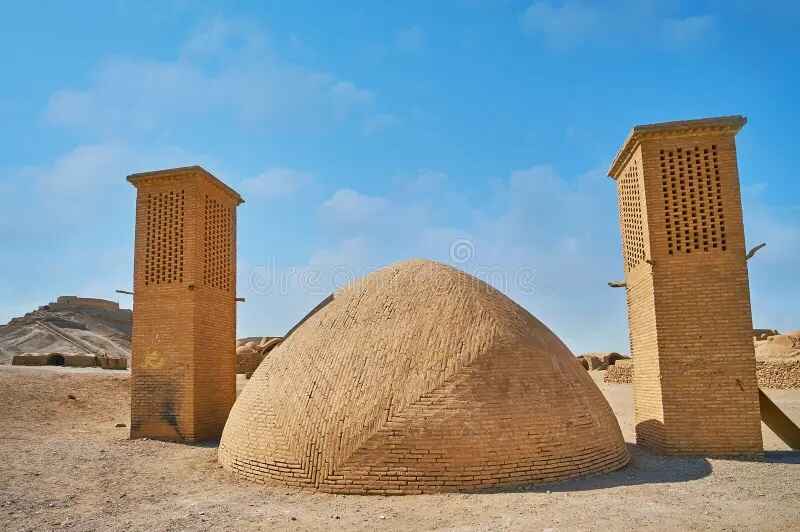
Early Yakhchals were constructed in key Persian cities, where the need for such storage was greatest. These structures were strategically placed near the ancient water management systems known as qanats. These underground channels, which transported water from distant mountains to arid plains, were essential to the operation of the Yakhchal. By building close to these sources, the Persians ensured a constant supply of cool water, which was a crucial component in the ice-making process.
As the Yakhchal evolved, so too did its significance within Persian society. It became a symbol of the empire’s advanced engineering prowess and its ability to manipulate the harsh environment to its advantage. The knowledge and techniques required to build a Yakhchal were passed down through generations, becoming an integral part of Persian architectural and cultural heritage. What began as a practical solution to a pressing problem gradually transformed into a celebrated aspect of Persian ingenuity.
The Science Behind Yakhchals: How They Worked
The genius of the Yakhchal lies not just in its construction, but in the sophisticated scientific principles that enabled it to function. At first glance, the Yakhchal might appear as a simple dome-shaped structure made of mud and bricks. However, the ancient Persians had embedded within its design a deep understanding of physics and environmental science, making it a true marvel of ancient engineering.
The Yakhchal worked on the principle of thermal inertia, a concept that modern science would later elaborate upon but was intuitively understood by Persian engineers. The thick walls of the Yakhchal, made from a unique combination of sand, clay, egg whites, lime, goat hair, and ash, were crucial in maintaining a stable, cool temperature inside. In addition to thermal inertia, the Yakhchal leveraged evaporative cooling, a natural process where water absorbs heat from its surroundings as it evaporates, thereby lowering the temperature.
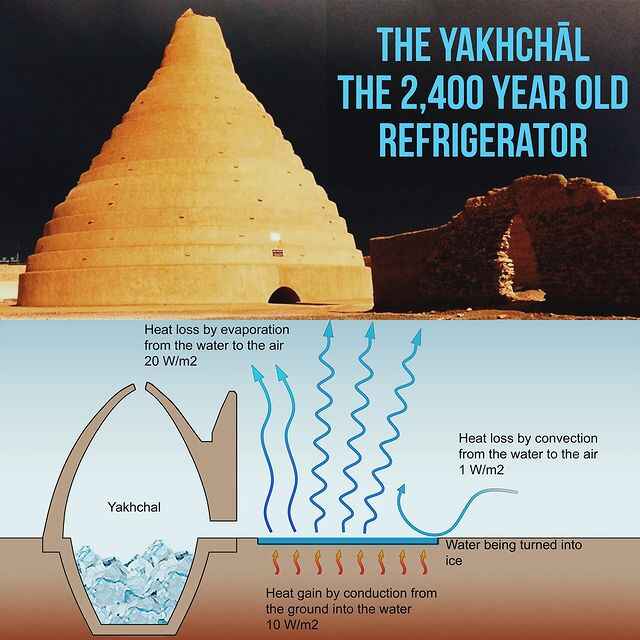
In addition to thermal inertia, the Yakhchal leveraged evaporative cooling, a natural process where water absorbs heat from its surroundings as it evaporates, thereby lowering the temperature. The Yakhchal’s dome, often painted white to reflect sunlight, had an opening at the top that allowed hot air to escape, while cooler air was drawn in through a subterranean channel connected to the qanat system. This clever design created a continuous flow of air that enhanced the cooling effect inside the Yakhchal.
Furthermore, the interior of the Yakhchal was meticulously designed to maximize its cooling capabilities. The deep pit, or the ice pit, where ice was stored, was always kept shaded and cool, further insulated by the earth around it. The structure’s location was also carefully chosen, often in areas where the natural temperature dipped lower at night, allowing the Yakhchal to harness this cool air to produce ice even in a desert environment.
Yakhchal Design: A Marvel of Ancient Architecture
The architectural design of the Yakhchal is a striking example of how ancient Persian engineers combined form with function, creating a structure that was both aesthetically pleasing and extraordinarily practical. The Yakhchal’s design begins with its characteristic dome, which rises prominently against the desert landscape. This dome, often constructed from sun-dried bricks, was more than just a roof; it played a critical role in the building’s cooling system.
The dome was constructed to maximize the Yakhchal’s efficiency in maintaining cold temperatures. Its convex shape helped to minimize the surface area exposed to the intense sunlight, reducing heat absorption during the day. Furthermore, the dome’s reflective white coating, made from lime, was a simple yet effective strategy to deflect the sun’s rays, keeping the internal environment cool. Beneath this dome, the walls of the Yakhchal were astonishingly thick—sometimes exceeding two meters in thickness. These walls were not just barriers; they were the key to the Yakhchal’s ability to preserve ice and food.
Inside, the Yakhchal’s design continued to reflect the ingenuity of its creators. The interior space was typically divided into multiple layers, each serving a specific purpose. The upper sections of the dome facilitated the circulation of air, while the lower sections housed the ice pit. This pit was where ice, collected during winter or produced through the Yakhchal’s cooling system, was stored. The pit was deliberately placed below ground level, taking advantage of the earth’s natural insulation to maintain low temperatures.
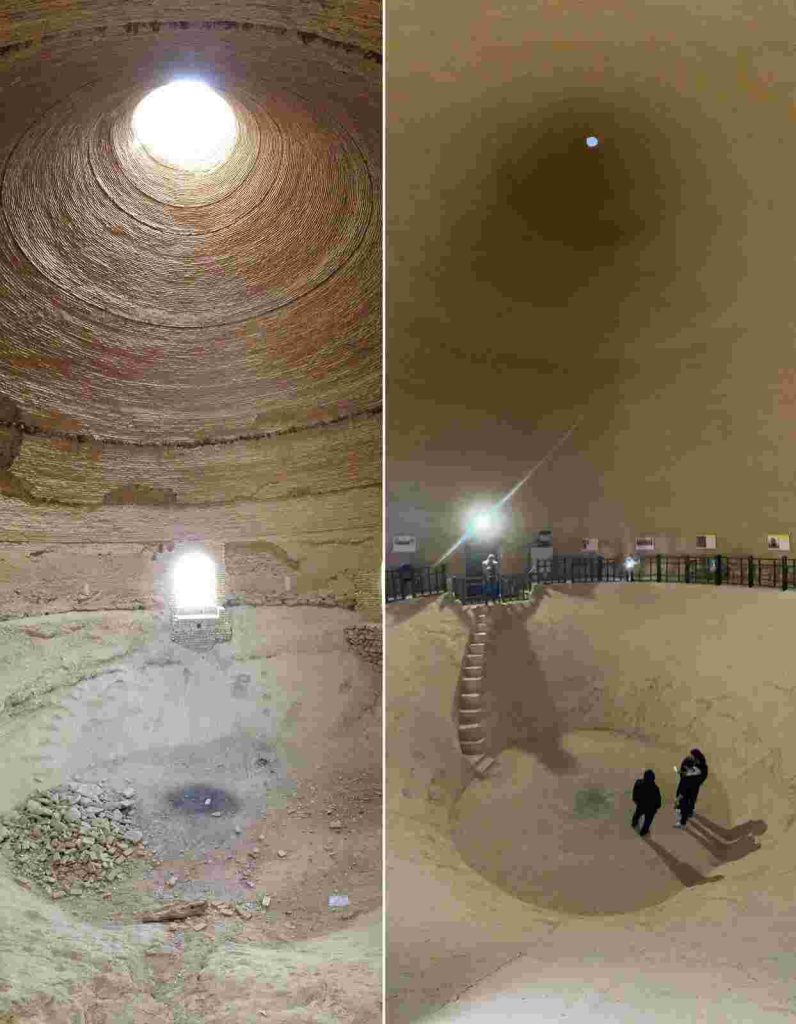
The entrance to the Yakhchal was usually small and strategically located to minimize the influx of warm air. This careful consideration of airflow and thermal dynamics allowed the Yakhchal to function as an effective refrigerator, capable of preserving ice and food for extended periods, even in the scorching heat of the Persian summer.
Frequently Asked Questions (FAQs)
1. What is a Yakhchal?
A Yakhchal is an ancient Persian ice house designed to store ice and food in the harsh desert climate. It uses natural cooling techniques like thermal inertia and evaporative cooling to maintain low temperatures throughout the year.
2. How does a Yakhchal work?
A Yakhchal works by leveraging thermal inertia and evaporative cooling. Its thick, insulated walls prevent heat from entering, while the structure’s design promotes the circulation of cool air, keeping the interior cold enough to store ice even in the desert.
3. How cold does a Yakhchal get?
A Yakhchal can maintain temperatures low enough to keep ice solid for extended periods, even during the hot Persian summers. The interior temperature can drop to freezing levels, effectively turning the Yakhchal into a natural refrigerator.
4. How was a Yakhchal built in ancient Persia?
Yakhchals were built using materials like clay, sand, and a special mortar called sarooj. The structure featured a deep underground pit, thick walls for insulation, and a dome to minimize heat exposure. They were often constructed near qanats, underground water channels that provided a steady flow of cool water.
5. Called a Yakhchal, which kitchen appliance did the Persians invent?
The Yakhchal is considered a precursor to the modern refrigerator. Its design and function laid the groundwork for the development of refrigeration technology, showcasing the ingenuity of ancient Persian engineers.
The Legacy of Yakhchals: Influence on Modern Refrigeration
The Yakhchal’s influence extends far beyond its original purpose, offering a glimpse into the ingenuity of ancient Persian society and its lasting impact on modern refrigeration technology. While the Yakhchal was designed to solve the immediate problem of ice storage in a desert climate, its principles have endured, subtly shaping the development of modern cooling systems.
The Yakhchal’s legacy begins with its foundational concept: using natural forces to maintain cold temperatures. This idea has carried forward into modern times, where the core principles of insulation, thermal inertia, and evaporative cooling are still utilized in contemporary refrigeration. The concept of ancient refrigeration wasn’t unique to Persia.
Across the vast expanse of the world, other civilizations, too, were innovating ways to preserve food and ice. In ancient China, the Jian served a similar purpose as the Yakhchal, using ingenious methods to keep perishables cool in a hot climate. The Jian, much like its Persian counterpart, was a precursor to modern refrigeration techniques, reflecting the shared human quest for practical solutions in diverse environments. You can learn more about the Jian and its fascinating role in ancient China’s food preservation practices.
In fact, the basic design elements of the Yakhchal—its dome structure, use of natural materials, and strategic placement—have inspired sustainable architectural practices today. Modern architects looking to reduce energy consumption often study the Yakhchal’s passive cooling techniques. This ancient technology is particularly relevant in the context of today’s push towards eco-friendly design, as it demonstrates how effective natural cooling can be without relying on electrical energy.
Moreover, the Yakhchal’s concept of storing ice through the winter months to be used during the summer has a direct parallel in the development of modern cold storage facilities. These facilities, critical to food supply chains around the world, use a similar approach of storing products at low temperatures to extend their shelf life. The connection between these ancient ice houses and today’s refrigeration systems is a testament to the enduring brilliance of the Yakhchal’s design.
The Yakhchal, in its essence, was a sustainable solution to a pressing need, and its principles continue to resonate, offering timeless lessons in resourcefulness and innovation.
Use of Our Content
⚠️ Content on “Mystery Uncover” is protected under US and International Copyright Laws.
You are free to reuse, republish, and share our content by giving credit to the source as Mystery Uncover with a link to the original material on mysteryuncover.com.


